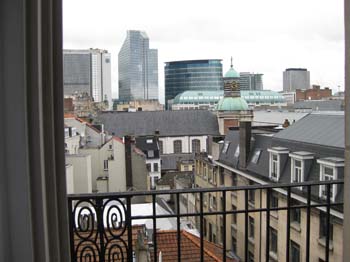 |
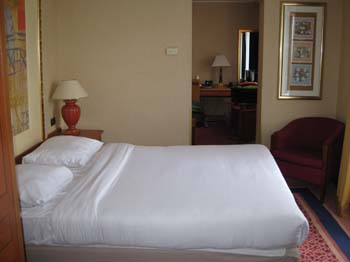 |
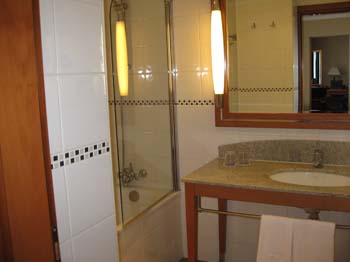 |
 |
Divorce time almost occurred when we found our seats – we were in 22 A & B, right before a lavatory and our seats did not recline very far. Future travelers beware! Perhaps most frightening, directly in front of us were a group of very lively and hard of hearing (as indicated by the volume of their conversations) travelers going to Paris together. We learned far more about their ailments than we ever wanted to know until our sleeping pills kicked in. We were awakened occasionally when the lavatory was flushed right behind our heads.
Arrival in Paris a little ahead of schedule, passed through immigration and collected our bags. The new Eagle Creek bags are lighter than our old ones and we squeaked through with our bags weighing only 35 – 37 pounds.
Our train to Brussels left several hours after our arrival at Charles de Gaulle. We made our way to the TGV station at CDG and picked up lunch to eat on our train. Salad and water for me, quiche and water for Mike. When our train showed up on the schedule board, we were a little surprised to find it also had an Air France flight number. So, we dutifully lined up 45 minutes before departure to check in. When it came our turn, the Air France agent told us we were not Air France passengers, we were simply TGV passengers but that our train would leave from Voie 5 the north access definitely. We decided to wait and see; we have been in a situation before where they changed the track number at the last minute. 10 minutes before departure, the schedule board declared that our train was leaving from track 3 south access. By this time, the Air France agents had taken all the passengers down to track 5 north access and loaded up their baggage on a caged baggage cart. We scooted down to the south gates found track 3 and waited. We found a display that showed that our car (car #6) would stop by embarquing point D. We found it and waited. Shortly, the Air France agents and baggage cart came running up the loading platform herding all their passengers. Naturally, we felt very smug….
The TGV ride was great except for the Italian teenagers right behind us who thought everyone in the car should enjoy their conversations. The countryside was lush, green and fairly flat. We ate our lunch and arrived in Brussels about 3 PM. It took us a few minutes to navigate Brussels’ Metro system. Interestingly, two or more people can use one fare pass as long as it has enough trips on it. Our hotel NH Atlanta is just a half a block away from the DeBrouckere Metro stop on Boulevard Adolphe Max 7. I was quite surprised to see that Mike had upscaled us to a 4-Star. We checked in and a very accommodating bellhop showed us to our room. Even though we requested a non-smoking room, we had been given a smoking room and it smelled like a cigar left five minutes ago. Our bellhop called the front desk and interceded for us.
As a result we ended up with a room with a balcony, a sitting room, a bedroom, and a bathroom! Quite an upgrade. However, internet access was 18.75 euros a day, needless to say, we did not sign up! We showered to refresh ourselves and went out for a stroll. We found, after a diversion through the shops at Passage du Nord, a shopping arcade built in 1882, a commercial pedestrian shopping area, the Rue Neuve, and the sprinkles started. We went back to the hotel and found our umbrellas and headed out in the opposite direction. We found a huge statue in the process of being dismantled (Three-legged Buddha by China’s foremost artist Zhang Huan) in front of the neo-classical opera house (the Theatre Royal de Monnaie in the Place de Monnaie. A little farther on we found Rue des Bouchers and strolled down this pedestrian avenue filled with restaurants. But, it was too early to eat! We strolled around and found the Opera Pub and shared some Beaujolais.
 |
 |
 |
 |
About 7, we were fading fast and found our way to Le Bourgeois, a seafood restaurant on the corner of Rue des Bouchers and Petit Rue des Bouchers . I had a great lobster bisque and sole meuniere. Mike had escargots and grilled mixed seafood platter. We shared a small bottle of cote de provence rose – I guess they didn’t realize summer was over. Mike said his was the best seafood ever, and we have a hard time topping the food and the service (and embroidered napkins) for 96 euros. rueDesBouchres, ruedesBouchres2
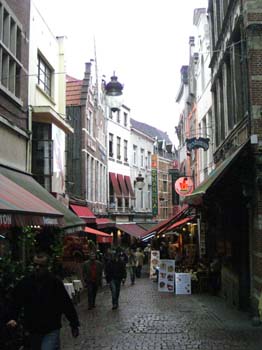 |
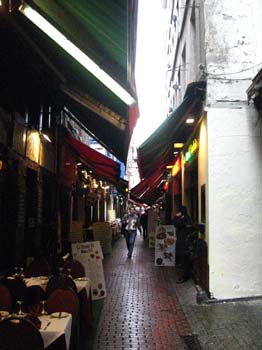 |
| They wanted to give us free coffees but we said we had to pass; so we could get back to the hotel and get some sleep. When we got back and checked the weather, we discovered rain for most of the rest of the week. But – at least, it’s raining in Paris, too. Brussels offers its citizens a great way to get around town – bicycles. | 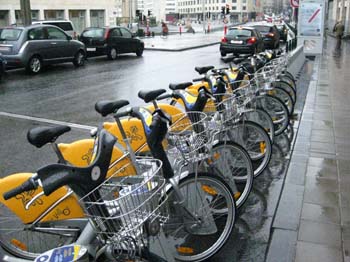 |
On our maps, we located a tourist office in Grand Place, and headed that direction. At the tourist office, I inquired (in French) from which station do trains leave for Bruges. The agent told me that trains for Bruges left from Gare du Midi, the train station at which we had arrived from Paris. Using the walking tours of Brussels in our guidebook, we checked out the heart of Brussels and then Sablons, through sprinkles and through heavier rain.
 |
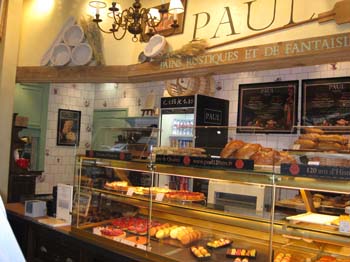 |
The gilded architecture in Grand Place is quite a treat. The Hotel de Ville sports a spire built in 1449 and 315 feet high and anchors the cobblestone square. The square is the geographical, historical and commercial heart of Brussels and hosted open air markets as far back as the 11th century, now home to a flower market. After the town hall was built, the guild houses making up the sides of the square were built by city merchants and traders. Only the town hall and two guild houses survived the cannonball bombing by the French in 1695. Trade guilds were encouraged to rebuild their halls to styles approved by the Town Council (sort of I imagine like Richmond’s Commission of Architectural Review) and the end result is a unified collection of Flemish Renaissance buildings. The square’s structures include the Maison du Roi (once the residence of ruling Spanish monarchs, now the home of the Musee de Ville), Le Pigeon (once home to Victor Hugo), La Maison des Ducs de Brabant (a group of 6 guild houses with stone busts of the dukes along the facade), a statue of Everhard’t Sercleas (who died defending Brussels in the 14th Century – touching his arm is said to bring luck), Le Renard (built in 1690’s as the guild house of haberdashers with St Nicholas patron saint of merchants on the front), Le Cornet (the boatmen’s guild house with its gable in the form of a 17th century frigate bow) , and La Maison des Boulangers (built by the wealthy and powerful bakers guild, it is topped by a 1676 octagonal copper dome topped by a dancing gold figure).
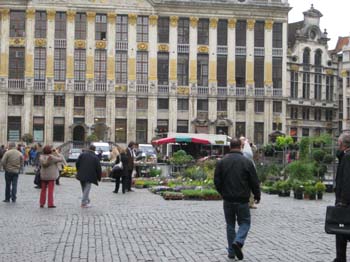 |
 |
 |
 |
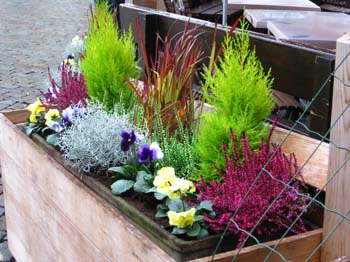 |
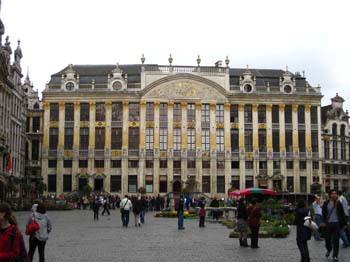 |
 |
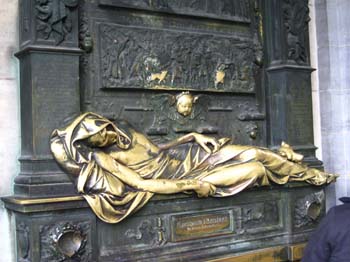 |
 |
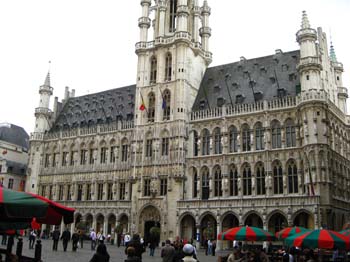 |
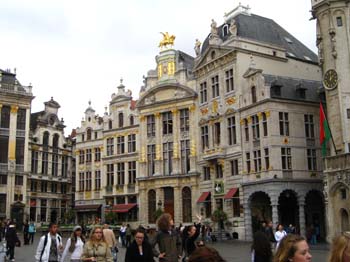 |
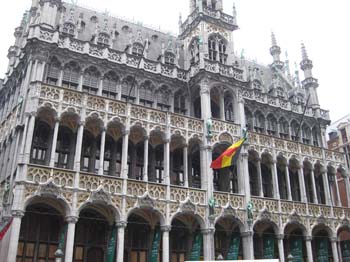 |
We left the square on the Rue au Beurre, passed the Biscuiterie Dandoy (at no. 31 famous for its buttery biscuits). We visited Eglise St-Nicholas, severely damaged in 1695 by a cannonball lodged in an interior pillar which collapsed the belltower in 1714. Rebuilt in 1956, the west façade was given a new gothic-style façade. The church contains choir stalls dating from 1381 displaying detailed medallions telling the story of St-Nicholas and art work by Peter Paul Rubens. Legend goes that the chapel was constructed at an angle to avoid the flow of an old stream. Evidently while the church was abandoned, merchants constructed shops against the exterior walls.
We double-backed a short way to check out La Bourse, Brussels’ stock exchange. It is the only building on its block giving it an impressive presence and was designed in Palladian-style. It has ornate carvings on the façade; with Auguste Rodin rumored to have carved groups representing Africa and Asia, as well as four caryatids inside. Once the site of frenzied trading, all trading is now computerized.
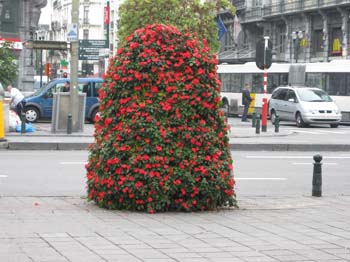
Going down the left side of La Bourse, on Rue Henri Maus, we located Falstaff, one of the few Art Nouveau cafes left in Brussels – dating to 1903. Crossing over Boulevard Anspach, we read in our guidebook that the boulevard was once the route of the river Senne, which was canalized and then covered in 1870. The entire area was marshland when settled in 7th century, and “Broucsella” meant settlement in the marshes.
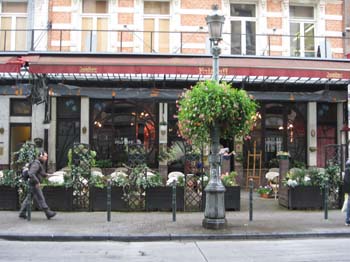 |
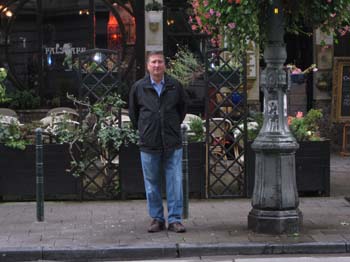 |
We continued on to Halles St-Gery, formerly the old meat market that covered the entire Place st-Gery. It is now a hip new restaurant. The square was an island until the mid-19th century and the River Senne still runs beneath. Across from the market, in the courtyard of a renovated apartment (23 Place St-Gery), we could see some of the river.
 |
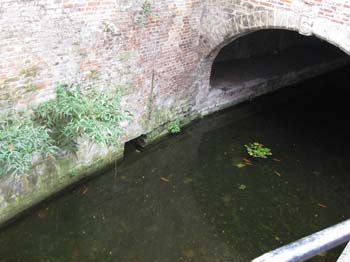 |
We left the square on Rue Antoine Dansart toward Place Ste-Catherine. Only the Baroque Tower on the Eglise Ste-Catherine remains from the original church built in 15th century. The current church, inspired by St-Eustache in Paris, was redesigned in 1854-59. Inside it houses the Black Madonna, a portrait of St. Catherine, and a typical Flemish pulpit.
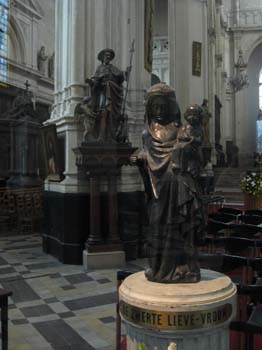 |
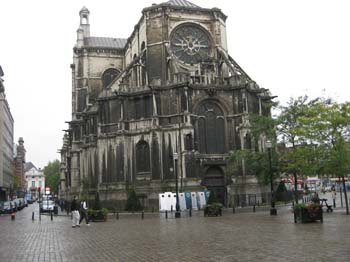 |
Just outside to the east is the Black Tower, a surviving remnant of the 12th century stone city walls. Walking around the rear of Ste-Catherine’s, we came to a broad open space lined by Quai au Bois a Bruler (firewood) and Quai aux Briques (bricks). The area between, once a canal, was covered over in 1870 and became the fish market. Now filled with fountains and pools, and surrounded by fish restaurants, the central area is filled with umbrellas and tables for dining in temperate weather. We vowed to return her for dinner tonight!
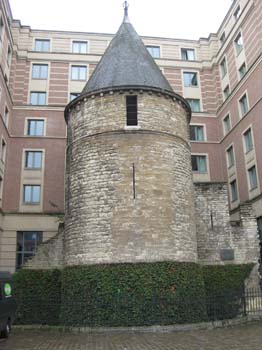 |
 |
| Rue de Peuplier took us to Eglise St-Jean-Baptiste-au-Beguinage. This stone-clad church was consecrated in the 17th century to serve the long-standing and largest beguine community. Fields and orchards previously surrounded the site and contained cottages and houses for the 1200 beguine women, members of a lay religious order who joined after widowhood or failed marriages. In medieval times, the beguines ran a laundry, hospital, and windmill for the city. | 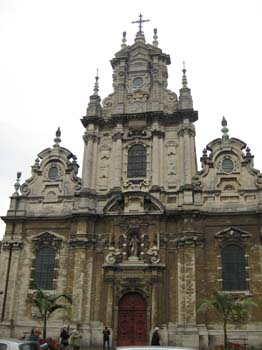 |
 |
We headed on toward the Place De Brouckere, where in 1872 a design competition was held to construct the buildings here. 20 winning applicants were allowed to surround the square with their buildings. Many of the buildings are of stone (common in France, whereas brick is more common in Belgium) and includes the Hotel Metropole (fabulous 1900-1910 Art Nouveau interior, visited by notables including Sarah Bernhardt, Marie Curie, and Albert Einstein). In the 1960’s two buildings with predominantly glass facades brought contemporary architecture into the varied historic architecture of the square. The huge lighted Coca-Cola sign on top of one of the neo-Classical buildings is enough to make one be ashamed to be an American. Back through Passage Nord, to Rue Neuve to Place Des Martyrs. In the center of this remarkably quiet square is a marble statue of Belga under which is a mausoleum for the 450 martyrs killed in the 1830 revolution that secured Belgium its independence and installed Leopold 1 as king. At one end of this square is the seat of the Flemish government. |
 |
Retracing our way Rue Neuve we continued up to Place de la Monnaie. Most traces of the statue we saw our first night are now gone, so obviously the Three Legged Buddha is leaving not arriving.
Walking on Rue L’Ecuyer we came to the entrance of Galeries St-Hubert, a shopping arcade dating to 1847 (this is the first in Europe and one of the most elegant). The vaulted glass roof covers three sections, Galerie du Roi, Galerie de la Reine, and Galerie des Princes. In the 19th century this was the fashionable meeting place for society. Today, the shops feature expensive goods and luxury shopping and restaurants.
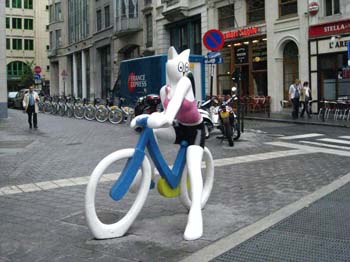 |
 |
 |
Halfway along, the gallery is intersected by the pedestrianized Rue des Bouchers. This area was designated the Ilot Sacre back in 1960 to protect it from development. Just off Rue des Bouchers is the Petit Rue des Bouchers and halfway down on the left is an alley called the Impasse, housing Brussels’ famous historic puppet theater. Back to Grand Place to start our second tour, this time of Brussels’ Marolles area. We left the Grand Place via Rue Charles Buls, passing tapestry and lace and tourist shops galore. Musee du Costume and Dentelle (lace) on Rue de la Violette was closed and we’ll come back another day. Continuing on Rue de l’Etuve to Rue de Chene, we found the famous statue/fountain Manneken Pis. This little fountain statue has 650 costumes on display in the Musee de Ville. The original was installed in 1691 – a tongue-in-cheek design reflecting a genuine need for fresh drinking water. It was stolen and broken in 1817 and a replica was cast and returned to its site the following year. His “sister” Jeannke Pis a cheeky female version was installed in 1987 in Impasse de la Fidelite off Rue de Bouchers in the spirit of sexual equality. We had seen it our first night, but didn’t realize it’s relation to the other fountain. |
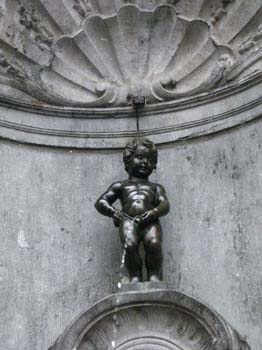 |
| Up the Rue de Chene to Rue de Villers, to find the Tour Villiers, the remains of a tower and section of the 12th century walls surrounding the city. Even though it was raining hard now, we continued on to the church of Notre-Dame de la Chappelle. A chapel was built on the site in 1134, it became a pilgrimage site after 1250 when a royal donation of five pieces of the True Cross turned it into a pilgrimage site. Much of the church was destroyed by fire in 1405; rebuilding began in 1421. Exterior features monstrous gargoyles peering down on the neighborhood. Across from the church is a city-maintained skateboard park. | 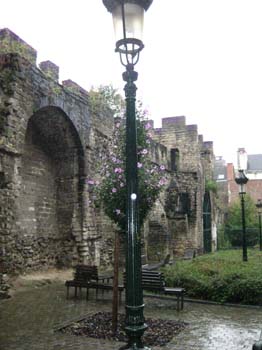 |
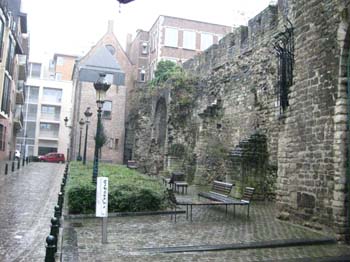 |
|
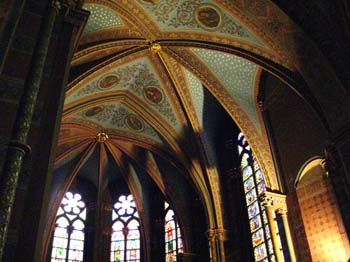 |
 |
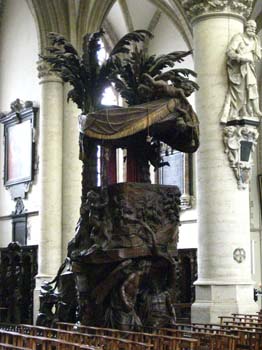 |
|
Still pouring, we continued south into the neighborhood known as Quartier Marolles, situated between the two city walls, home to weavers and craftsmen. Following streets not on our tour, we found antique and brocante shops, furniture stores, and even fabric stores.
Weaving around the streets, we found Place du Grand Sablon, dividing upper and lower Brussels. The fountain in the middle of the square was funded by an Englishman; the square is surrounded by elegant townhouses and, even in the rain, seems to be a chic part of Brussels. At No. 12 we found, Wittamer, supposedly one of Brussels’ most celebrated chocolate makers – but there wasn’t a lot of chocolate around when we were there.
The rain was driving us back toward a rest stop, we abandoned the tour and headed for Cathedrale Sts Michel et Gudule, passing the national library, rose gardens and the equestrian statue of Albert 1, the “soldier king” who led troops into World War 1
.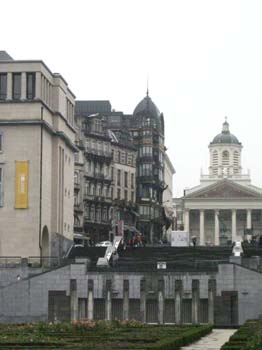
The cathedral was immense and featured a stained glass window called the “Last Judgement,” highly ornate baroque pulpit, statue of St Michael (Mike’s namesake since he was born in St Michael’s Hospital and his mother couldn’t come up with a name until she was ready to leave the hospital and they demanded one for his birth certificate), and a statue of Ste-Gudule, a saint dear to people of Brussels. The twin towers of the front of the cathedral were very reminiscent of those of Notre-Dame in Paris. The crypt contains remnants of the first church on the site dating from 1047; some can be seen through a grate in the floor of the cathedral.
Sopping wet, we headed back toward the Grand Place and a cup of hot chocolate and our first Belgian waffle. Then back to the hotel to plan for dinner. Our plan for dinner at the location of the old fishmarket by Ste-Catherine’s went awry when we started checking out menus. The prices were very high and even the prix fixe menus were high. Realizing our Belgian waffle earlier had left its mark and neither of us was hungry enough to spend 50-60 euros each on dinner, we wandered back to Rue de Bouchers and found Luna di Venezia where Mike could have mussels and I had a grilled sea bream fillet with a dijonnaise sauce and we split some house red wine.
On our way back to the hotel, we wandered through Grand Place to see it lighted up at night. Even in the rain it was a busy place. At Place du Monnaie, the statue and all of its remnants were gone.
Clearer skies than we have yet to see in Belgium started off our day. We took the Metro to Gare du Midi and bought round-trip tickets to Bruges. We hopped the train, arrived in Bruges in about an hour. First stop was the tourist information center to get a map of the city and recommendations from the agent. Since the Markt was only a 15-minute or so walk from the train station we elected to walk instead of taking the bus. We had mapped out a walking tour of our own to hit the highlights that most interested us.
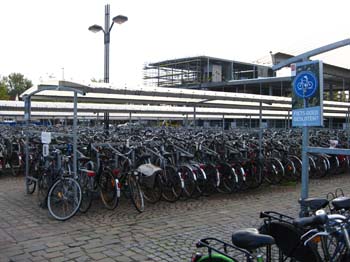 |
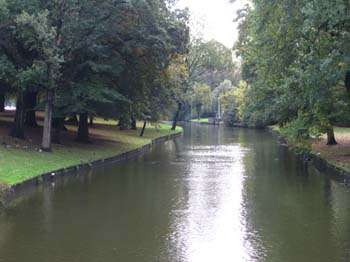 |
Bruges is a medieval town that has been remarkably well preserved. The pedestrian scale of the town including the streetscape, canals, cobblestones was very welcoming. We walked past St-Salvator Kathedral on our way in, vowing to check it out on our way back to the train station. First stop was the Market (the main square which has held a market since the 10th century). The Belfort, or belltower, anchors one side of the square, rises 272 feet into the blue sky, houses. Centered in the square is a statue of two guildsmen who led the rebellion against the French in 1302, ultimately defining the rights such as the right to free trade in the town’s charter (until the 15th century!) A canal used to permit goods to flow into the square, but it has been filled in a replaced with a building housing the administrative offices of West Flanders. On another side of the square is a the Huis Bouchotte – its façade features a compass, attached to a weathervane, which informed merchants the direction of winds for incoming ships.
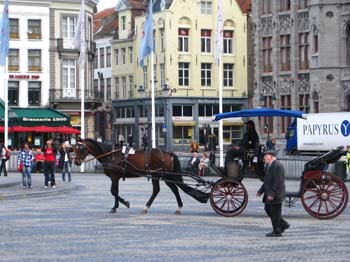 |
 |
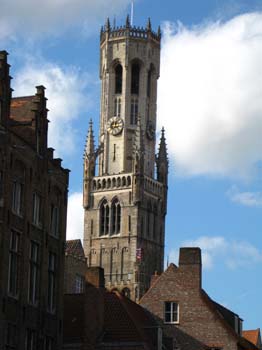 |
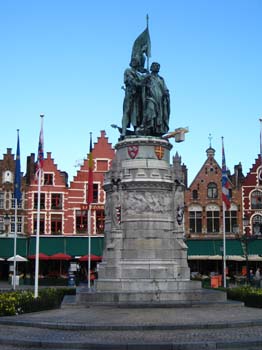 |
We left the square on Vlamingstraat and walked past the town’s neo-classical municipal theater dating to 1868 (one year older than our house in Richmond). We passed a lodge for traders from Genoa that dated to 1399. Nearby we found Huis Ter Beurze where merchants and bankers exchanged credit notes as early as the 13th century. Rumor has it that it was the first stock exchange and is the origin of the French word for stock exchange Bourse.
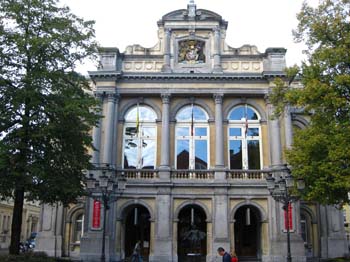 |
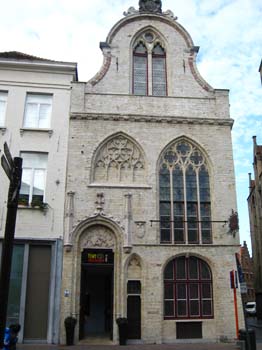 |
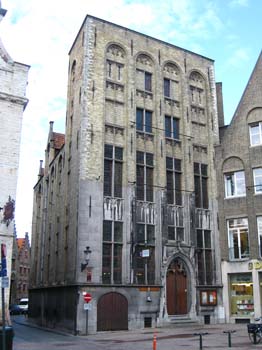 |
On Academiestraat we found the Burghers’ Lodge, a gathering place for the upper class. It has a tower that was rebuilt in 1775. On the other side of the street is t Old Customs House where customs were assessed. The old weighbridge has been replaced by a city square, complete with a statue of Jan van Eyck, Bruges’ famous artist. The canal now stops here and we walked along it, taking a little detour to check out a baroque church built for the Jesuits in the 17th century. Retracing our steps back to the canal, we crossed over the canal to Blekersstraat, where we found Bruges’ reputedly oldest tavern, the Café Vlissinghe, dating to 1515.
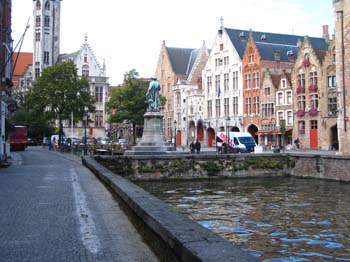 |
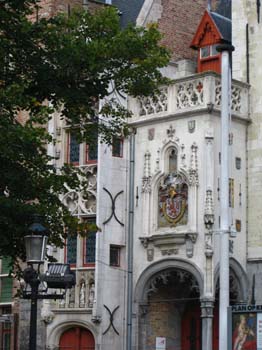 |
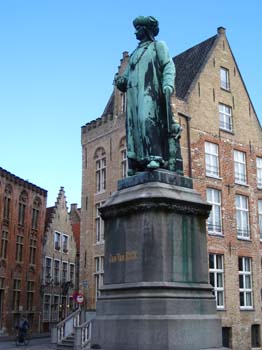 |
We continued down Blekkersstraat to the Jerusalemkerk and then on to the Folk Museum, fearing it may close for lunch. The museum is in a series of low almshouses and houses artifacts of Flemish life. Each house/room features a different aspect: a classroom, shoemaker’s shop, clogmaker’s shop, grocery, cooper’s trade, pipe and tobacco artifacts, a tavern the Black Cat, a Flemish living room and kitchen, confectioner’s shop, chocolate molds, apothecary, hat shop, tailor, and signboards. The old tools, washing machine, sinks, cabinetry in the apothecary shop held our interest for some time. Unfortunately, photos were not allowed.
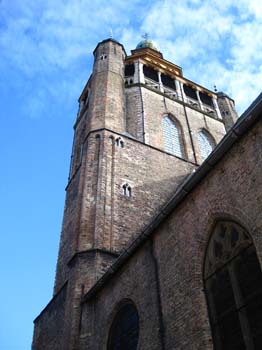 |
We headed over to the windmills which sit where the old city walls stood. The city wall was further protected by a moat which is still in existence (walls taken down in 19th century). At one point there were 20 windmills only 3 are left, and one is original to Bruges, even though it was restored in 1770. Farther on we found Kruispoort, a gate from 1402, that guarded the eastern approach to the town. It is now all that is left of the city walls.
On our way back to the Markt to find a place for lunch, we passed through the Burg. The town hall is here, built of sandstone with a façade dating to 1375 it has a Gothic Hall noted for its 1385 vaulted ceiling. The Provost’s House next door was built in Baroque-style of grey stone in the 17th century.
We lunched on traditional Flemish fare at a restaurant in the Markt, enjoying t blue skies and the sun. Mike had filet of Oostendt herring and rabbit in the Flemish style. I had Flemish ham and melon with Flemish beef stem. Our beers came in glass containers set in a wooden holder – quite a different experience.
After lunch we headed back to the Burg to walk through Blind Donkey Alley, a narrow arched alley, to get to the fishmarket. The open air fishmarket is usually busy early in the morning but by afternoon was deserted. We climbed aboard one of the canal tour boats and took a ½ hour tour of the city by water, retracing many of t places we had walked earlier, but with a different view. It was kind-of Disney-ish but it was fun.
After our tour we walked along the canal on Rozenhoedkaai and Diver to the Church of Our Lady. Its spire was under renovation and masked by scaffolding and construction tarps. The main entrance was blocked. We wondered if the restoration will take as long as the original construction (200 years). Michelangelo’s sculpture Madonna and Child from 1504 is here.
On our way back to the train station, we stopped in to visit St Salvator Kathedraal to check out the eight Brussels’ tapestries representing the Life of Christ. It, too, I sin the midst of renovation. The exterior has been completed, the interior is scheduled to start in 2010. However, most of the artwork and statues were covered in preparation for the work to come.
We caught the train for a very pleasant ride through the countryside back to Brussels. Skies were clear in Brussels, too – so we sat outside at the Hotel Metropole and enjoyed a glass of wine. We revisited the Grand Place at night – just to see it without rain and, then headed back to the hotel to pack for our return to Paris to meet Glenn and Kimberly.
We checked out of our Hotel, hopped the metro a ½ block a way, took it 4 stops to the train station. Luckily, we scoped out the route on our way to Bruges and knew where all the elevators and escalators were located. At the train station, we stopped for a coffee and croissant and people-watched until our train came up on the schedule board. Once at our platform/gate, they displayed a sign that said DO NOT BOARD! We watched and as soon as it changed to welcome us aboard, we hopped on board to stow our suitcases in the luggage area before it got too full. The conductor yelled at us to get off the train, then he looked down the track and saw the sign, shrugged his shoulders, and let us on- despite the fact the crew was still cleaning.
The THALYS was just like the TGV, comfortable, and at points exceeding 290 km/h. Naturally it slowed down through cities and towns, but the overall speed average was 186km/h. On the train we tried to match up photos with the text of the journal. As we were working through them, we realized we didn’t have all the photos on the pc and Mike said he’d make sure to check out the rest.
We arrived at Gare du Nord in Paris a few minutes late, but the most delaying factor in getting to our hotel, Hotel Mansart on rue des Capucines, was standing in line to get metro passes. We were in line for 25 minutes – at least. We even got behind a tour guide buying over 1000 euros worth of passes. The agent was a vey cute young lady with long blond hair, spoke English, and actually thought she was working tourist information – she spent so much time with each customer, discussing what they could see, what she would recommend, how to ride the Metro, etc. Finally, our transaction for tickets is complete and off we go to meet Glenn and Kimberly at the hotel. We metro from Gare du Nord to Opera, climb the steps at Opera and off we go down rue del Paix toward the place de Vendomme and our hotel. Glenn was hanging out the window when we arrived, calling to us – sort of like an old French movie.
We checked into the hotel (room 306) and dropped our bags. By now lunch was way delayed, so we went out the front door to the right and found a great little spot in the next block. Green bean salad, roasted chicken and mashed potatoes with cheese and butter, beef Bourgogne – and a bottle of wine.
We headed over to the Petit Palais to check out the permanent collection, then to the Grand Palais to see the new exposition. But the new exposition required advance reservations and folks were in a weaving queque throughout the plaza. We abandoned the Grand Palais plan and walked over to Blvd Haussman to go through Jacquemart Andre and see their new exposition of a collection of Belgian and Dutch painters. We squeaked out just before closing time and headed back to the hotel, stopping by Sotheby’s to check out what would be auctioned off the following weekend. At the hotel we took a few minutes to get ready for dinnerat La Cordennerie with Hugo. On the way to La Cordonnerie, the skies opened up and luckily we all had umbrellas. When we arrived Hugo had a cancellation and we were able to sit in the kitchen after all. I had daurade (sea bream), Mike had swordfish, Glenn had deer stew, and Kimberly had veal. Dessert was a fabulous chestnut cake and, of course, the chocolate fondant. This was Glenn and Kimberly’s arrival day in Paris and we were anxious to get them back to hotel for some sleep – they made it through to almost 11PM.
Up early for coffee and croissant at the petit dejeuner at the hotel, then off to catch the train to Versailles. We spent most of the day enjoying the sights of the grand castle and its beautiful gardens. We entered through the huge iron and gilt gates into the courtyard facing the street. The current palace grew out of a series of renovations to an original modest hunting lodge. The first took place in the 1660’s. In 1678 Mansart added the two large north and south wings and filled in an existing terrace to become the Hall of Mirrors. The chapel was finished in 1710 and the Opera House (not open to public) was added in 1770, built for the marriage of Louis XVI and Marie-Antoinette. We entered the north wing and visited the Chappelle Royale, Mansart’s last great work, a two-story Baroque chapel. We walked through an exhibition of paintings, walked into the marble courtyard with its huge clock with Hercules and Mars flanking it, into the entrance to tour the Salon de Venus with its statue of Louis XIV amid a rich marble décor, through grandly appointed rooms to the Salon d’Apollon, which was Louis XIV’s throne room, to the Salon de la Guerre with its war-theme and then ito the fabulous Hall of Mirrors. Great state occasions were held here amid the crystal chandeliers, gilt decoration, and of course those mirrors bouncing light al over the room and reflecting the gardens outside. The interiors were designed by Charles Le Brun, who was obviously the king of more is better! The rooms were richly decorated with colored marble, stone and wood carvings, murals, velvet, rich brocades, heavy embroidery, and silver and gilt furniture. Off the Hall of Mirrors nestled between two wings were the king’s apartments, including his bedroom, library, boudoir, etc. Back into the Hall of Mirrors to get to the Queens Apartments, with her bedroom (where she gave birth to royal children in public view), sitting room and other rooms that afforded the Queen more privacy. In Versailles all day Chapel and 17th century galleries, State Apartments (Hall of Mirrors, Kings Chambers), History of France galleries, Dauphin’s apartments, Mesdames Apartments. And, of course the gardens by Andre LeNotre.
We ate at a little restaurant along the path to the grand canal – tucked back into the trees of the garden. At 3:45 the water fountain display started since due to the drought, the fountains do not all run nor do they run all the time. The fountain of Latona just down the marble steps between the parterres was the signal the show had begun. We walked the geometrically laid out beds and paths to the Grad Canal and eventually to Marie-Antoinette’s estate Petit Trianon.
We rode the tram back to the Chateaux and walked back to the train station to catch train back to Paris. On the way back, we decided to find the International Food and Wine Festival that was happening “at the base of Montmartre.” Making our way up the butte, we found the festival surrounding Sacre Coeur at the top of the hill. We tasted a few wines, sampled oysters from Brittany, and pushed our way through the mob. At 8:30 we decided to leave the area to find a place to eat dinner. We metro’d back to Opera and found a bistro where we had salmon, and faux filet and a pitcher of wine. We noticed that La Taverne across the street was closed. Back to hotel to get ready for train ride to Vannes tomorrow.
Caught train and headed through beautiful countryside towards the western part of France.
Train arrived in Vannes at 1:45 not 1:13. Mike and Glenn go to get car – office closed. We can get a train to Auray, then bus to Carnac, then cab or walk. Glenn called our landlord, Thibaud, and he graciously offered to come get us. He his wife, Catherine, and daughter (Emy) showed us around this great little place. They left, we walked around town and along the beach. Picked up coffee and necessaries. Ate moules and frites at a restaurant overlooking the beach. Home to bed!
Mike was up early to call Europcar to try to straighten out our lack of rental car. Finally he was able to negotiate picking up the car in Auray and dropping it off at Vannes on Saturday when we leave. The next obstacle was how to get to Auray, a town on our list to visit anyway. Called a taxi and he picked us up and took us to the Europcar rental office for 25 euros. Picked up our car, without a hassle, and drove toward the center of town and its Monday morning market.
Found a place to park near the hospital and walked the market and the town. At the market, we bought three different cheeses, after being thoroughly entertained by the cheesemaker and his wife; we brought home a Tommes de Montagne and Gruyere (cow) and a Bleu de Brebis (sheep). The cheesemaker knew only one word of English YES, and the rest of our communication was in poor French and sign language or sounds like MOO and BAA to signify cow or sheep’s cheese. Unfortunately, Mike and Glenn missed all the fun and entertainment.
Next we found some great strawberries (last of the season) and strawberry preserves from a vendor whose table had only strawberries and preserves. Just across the way, Glenn and Kimberly found the perfect fabric to make pillows for the cottage’s porch. Glenn handed the vendor money for the fabric, the vendor handed Glenn back the extra, and Kimberly took it from Glenn. The vendor laughed and told Glenn in English – it’s the same in France.
Auray is built on a hill overlooking the Loch River and boasts old houses and a cute little harbor reached by crossing a stone bridge dating to the 17th century. This is where Ben Franklin arrived to seek aid from the French during the US’ Revolutionary War. Just across the bridge, we found L’Armoric, 1& 3 Place St Sauveur, to sit in the sun and eat lunch. Kimberly and I had a lunch special of a ½ pizza with a salad. Glenn and Mike tried to have the plat du jour – but it was sold out. The waitress offered to see if the chef would substitute cod in the special and serve it with sweet potato puree and a celeric charcroute.
After lunch we explored the St Goustan area, known for galleries and old residences. We visited the old church on the top of the hill named for St Goustan, the patron saint of mariners and fisherman. Back down the hill toward the harbor and back across the bridge to the center of town, past the town hall built in 1776 where the market has broken down and there is no trace of its existence. On the way back to the car, we visited the Church of St-Gildas with a Renaissance doorway and a baroque altarpiece.
We found the car and set out through the countryside for La-Trinite-sur-Mer. The bright, sunny day was perfect for a ride through the countryside. La Trinite is the sailing center and the harbor was chock full of boats of all kinds – it can hold 1200 boats. There were several large racing trimarans moored on which maintenance and improvements were being executed. We strolled along the harbor and its shops. Back to the car, we drove down to the Pointe de Keribahn, where the river joins the bay de Quiberon. The views were spectacular.
We found our way back to Carnac and stopped by the Super U to pick up some necessities, like paper towels, wine, fruit, etc. Back home we unpacked the supplies and sat down to enjoy our food purchases. We started out with a white Sauvignon, one of the cheeses, an apple (La Reine des Reinettes), those fabulous Plougastel strawberries, salmon pate, and a spicy sausage and ended up with a Les Gravelles Bordeaux, as we made plans for dinner.
We mapped a route to take advantage of Brittany’s coastline and to see its fishing villages and centers. From Carnac, we headed to Quimperle, an inland town where the Isole and Elle rivers meet. We walked the lower and upper areas of this picturesque town dating back to the 11th century.
We drove on to Pont-Aven, a cute town with 17th and 18th century granite houses situated on streets that seem to rise in tiers from the port, built on a ria (ancient term for a flooded valley). Here we even found a thatched roof.
We continued on to Concarneau, an old sardine fishing center, with a large harbor and a walled city – the earliest fortifications date to 14th century. We ate lunch at a restaurant overlooking the walled city, sitting out in the sun – L’Amiral, 1 Avenue Pierre Guegin. Plats du Jour for Glenn, Kimberly, and Mike (pasta with a white fish probably cod and a very light butter sauce) and Salade Nicoise for me. Mike’s phone rang just after we ordered and it was Thibaud, wondering if everything was ok and if we were able to get a rental car, what we were doing, etc. At lunch, the man and wife seated at the table next to us asked us where we were from, etc. During the conversation, they said they lived on the island in the bay, but were visiting his sister who lived there, he also gave us a long list of suggestions of a driving tour to see more of the coast and fishing towns. We drove through Fouesnant, known for its butter biscuits and cider, on our way to Benodet, a coastal resort known for manor houses and chateaux that line the river and harbor. We walked along the lovely white sand beach, found the remains of an old German bunker guarding the port. One had even been transformed into a dwelling. At Pont l’Abbe, we found the museum closed – it houses a collection of traditional costumes. We strolled the town streets, window shopping and checking out potential buys, like traditional striped jerseys.
We decided to drive to L’Orient for dinner. L’Orient was almost totally destroyed during WWII, and was rebuilt in a very contemporary style. The pleasure boats are docked along a marina on both sides of a canal, divided by a lock and a bridge. As we walked along checking out the pristinely maintained boats, several came in, evidently, from a race. On the way into the town, Glenn had spotted a few potential dinner spots, which turned out to be bars not restaurants. But, across the square, we found L’Alhambra. Mike, Kimberly and I had duck breast, Glenn had steak and frites – his first of the trip. We returned home to Carnac in the dark and somehow negotiated our way back to our cottage, arriving at about 10:15 PM.
It was another bright, beautiful sunny day and the scenery was beautiful as we drove to the southernmost part about 9 miles out. The port was well protected and is a jumping off point for a ferry to Belle-Ile,, the island where the folks we met yesterday live. We strolled the beach and found a restaurant in the sun and out of the breeze. Lunch was rose, a chef salad for me, a salad wit fruits de mer for Kimberly, and the menu of the day (oysters and calamari) for Mike and Glenn. We walked the beach after lunch, saw folks lying in the sun and a couple of people in the water. Brrrrr!
Back at the car, we took the Cote Sauvage road along the western shore to check out the gorgeous scenery of cliffs indented with caves and chasms and pounding surf. Mike crawled at a snail’s pace, Glenn rode with the door open to have an unimpaired view. We stopped several times for photo opportunities. At our last stop, we watched the surf pound against the rocky shore and watched surfers catch a wave! We passed the Fort Penthievre, built in 19th century and now property of the French Army.
We stopped by the store picked up oysters for appetizers and seafood for fish soup for dinner. Then, home and while Mike and Glenn prepared dinner, Kimberly and I walked to the end of the beach in Carnac. Families were playing along the beach, runners running, folks walking, and even some few swimming. The light was beautiful, a soft warm glow and as the sun set it changed into a soft pink with a tinge of purple. Back at home, we settled in for wine and oysters, cheese, bread. Glenn was able to shuck the oysters in a matter of minutes – faster than he ever been able to shuck them in the past. Glenn, Mike and Kimberly shared 24! Mike reported that as he prepared the seafood, it was so fresh that all you could smell was the ocean. Our fish soup was fabulous, as was our salad with fresh figs from France!
Another sunny day, but a little cooler! We drove the 60 miles plus or minus (about 1 hour and ten minutes) to Quimper. We parked along the quai along the Odet River. Quimper is also at the confluence of two rivers: Odet and Steir. The bridges/walkways over the Odet were all festooned with boxes filled with lovely annuals – still beautiful in October. The cathedral and the museum of Breton life were on our left, across the Odet. We crossed over, the landscape crew was replacing the summer annuals with winter color and cleaning and compressing the stone dust walkways.
We had time before lunch-closing to walk through the museum. The museum had a collection of artifacts back to prehistoric times. I was most interested in the folk costume collection; and Kimberly in the faïence collection. The museum itself is housed in the former bishop’s house – attached to the cathedral. By the time we left the cathedral, it was closed for the lunch hour. We cruised the two squares (Laennes and St-Corentin), remodeled to feature a statue of Rene Laennec, inventor of the stethoscope and a carousel from the early 1900’s with a submarine-like coach that looked like a Jules-Verne type feature.
We walked along several of Quimper’s streets with timber-framed houses (rue de Boucheries, rue de Kereon, rue St Francois) on our way to the covered market, filled by now with students on their lunch hour. The market was filled with fresh fruits, vegetables, wonderful cheeses, meats, pates, prepared foods, and of course seafood of all kinds even sardines. This was the first market where we saw multiple kinds of clams. There was even a fresh pasta booth and sushi and sashimi! The market was filled with locals, buying items for their supper.
We decided to get crepes for lunch and went to Creperie de la Place au Beurre, 2 bis Place au Beurre. We had a assortment of crepes: mine was oinions cooked in red and white wine, Kimberly had scallops in her crepe, Glenn had ham, cheese, mushrooms with a cream sauce, Mike had a crepe with eggs, ham, tomatoes cuisinnee, mushrooms and cream sauce with a bit of salad. We chose to try the brut cidre to accompany our meal. For dessert we tried crepes with chocolate and crepes with chocolate and coconut.
We cruised the town a little more, checking out the shopping and all the old buildings. Then back to the cathedral, which was now open. The cathedral is dedicated to St Corentin, the first bishop of Quimper, who left his existence as hermit to become the leader of the Quimper congregation. The cathedral dates to the 13th century and is light and airy due to the ribbed vaulting and flying buttress construction. The choir was built out of align with the nave to take advantage of an older chapel containing the tomb of Alain Canhart, instrumental in repelling the Norman invasion of 913. The sun was streaming through the stained glass windows during our visit and we had a exceptional view of these windows constructed during the 15th or 16th century in a local workshop. The brilliant colors were a wonder to behold. The pulpit of wood with medallions of gilt wood carved to feature events in the life of St Corentin. The Romanesque nave was rebuilt in the 15th century and contains the tombs of all the bishops of Quimper.
We left the cathedral to explore the rest of the center of town. On our way back to the car, Kimberly and I went into to the post office to get stamps for her postcards to the US. The stamps were .85 euros each. Glenn took photos of the spires of the church while we negotiated for stamps and Mike went back to the car to make sure we didn’t get a ticket.
We stopped by the Faiencerie-HB-Henriot to look at their faience which is reputed to be the last of the factories to still produce pieces with freehand decoration. We looked at the offerings in two nearby shops and the difference in quality was quite evident. We even saw a platter that was priced at 3,900 euros – it was very similar to several we saw in the museum in terms of colors, intensity, and intricacy of design.
We left Quimper and headed back southeast to Locmariaquer, a resort town on the edge of the Bay of Morbihan, noted for its megaliths. The town was cute, but everything was closed up tighter than a drum and dinner there was out of the question. The megaliths are located just up from the cemetery, on a knoll overlooking the bay. The Table des Marchands is a Neolithic grave dating to 3700 BC. The site of the megaliths also houses the Grand Menhir Brise, dating from 4500 BC, it is 65 feet long (tall). It is broken into four pieces and is the largest known menhir in the western world. We drove home through St-Philebert and Trinite-sur-Mer on our way back to Carnac. First stop was for wine at the Super U, then home to take a bottle of wine to the beach and watch the sundown and the magic of the dusk light on the beach. We collected a few shells and walked the two blocks home. Instead of dining out, we finished up some of our cheeses and snacks and had left over fish soup, vowing to try one of the restaurants tomorrow that looked so lively in Trinte-sur-Mer as we drove through.
On our last day in Brittany, we decided to tour the eastern portion of Loire-Atlantique to find out how they farm salt from the sea. We drove to Guerande, walked through the old town, its ramparts dating to the 14th and 15th century. The Porte-st-Michel gate was flanked by two towers, as we wandered through the walled town, we checked out shopping opportunities. Driving south from Guerande, we meandered through the salt marshes and saw mounds of salt covered by tarps. We even saw a man working his salt ponds or as they say “salt-panning.”
Next stop was Le Croisic, a cute resort town situated on a peninsula jutting out into the Atlantic. We stopped for lunch here and strolled the beachfront. We continued on to La Baule, with its 5-miles of white sand beach. It is an old resort town that allowed its historic properties to be replaced with highrise apartment buildings lining the shore. We were not impressed, even though a few historic homes dotted the town. Continuing down the beach, we passed through Pornichet on our way to St-Nazaire. St Nazarine is a ship building port – actually cruise liners like the Normandie (launched in 1932) and the France (launched in 1960). By the docks, we found a group of men playing boules and farther out along the quai, we watched the start of a sailboat race.
Since it was getting late, we hurried on to Vannes to check out the gardens just outside the rampart walls, beautifully landscaped and maintained. We parked just outside the Place Gambetta, along the quai with pleasure boats docked. We walked around the old town, window shopping and people-watching. The Cathedral of St Peter is also dedicated to St Vincent Ferrier whose tomb is housed there. It was built in the 16th century and is currently undergoing renovations, especially of its Renaissance Tower. Some of its windows and art were covered or removed to preserve them during the project. One of its chapels is dedicated to St Ann, Mary’s mother and the patron saint of Brittany. We found the fish market, closed of course by this time of day, and wandered back to the Gambetta gate to leave the walled city. We stopped at La Gambetta, a café overlooking the harbor and had a glass of wine.
We drove on toward Carnac, stopping at La Trinite-sur-Mer for a fine dinner of Gratin de la Mer for Mike, Kimberly and me, and grilled St Pierre for Glenn. Back at our cottage, we began preparations for our train ride to Paris tomorrow morning.
We arrived at the train station in Vannes, dropped off the rental at Europcar, and caught our train to Rennes where we would change to a train to Paris. The train to Rennes was a regional train, all seats were 1st class and I wished airplane seats were as comfortable. At Rennes we caught a TGV to Paris and arrived in Paris around 3 PM. We walked from the Gare Montparnasse to our Hotel on Rue de Gergovie. The hotel was pleasant, newly redone, new comfortable beds, flat screen tvs, but alas we were on the third floor (French so really 4th floor) and they had no elevator. It was coming, hopefully by December! We deposited our bags and grabbed the metro to the Champs Elysees. After window shopping and shopping for Kimberly, we strolled up toward the Arc de Triomphe. Walking back, we noticed the sidewalk packed with people, people in uniforms, groups of young people standing at attention, a band, people carrying regimental banners, and elderly folks wearing tricolor sashes with badges on them sanding next to wifes, children, grandchildren etc. The young people in uniform marched to a side street to start the formation. On the Champs Elysee sidewalk across from the side street the band was hitting a note or two. Out of nowhere, police cars arrived and blocked the street leading up to the Arc de Triomphe. First the band, then the group carrying floral arrangements and regimental banners, then the young people in uniform and finally the rest of the crowd all marched up the Champs Elysees to the Arc de Triomphe and laid the flower arrangements to honor those who have lost their lives in war. Glenn found out from one of the participants that this happens only once a year, that every regiment has at least one representative to carry its banner to honor their fallen comrades. And, we stumbled into it!
We found a café to have a drink called L’Alsace and devised a plan to find a restaurant for dinner. After our brief pause, we hopped the Metro back to Montparnasse and strolled Boulevard Montparnasse looking for a place to find steak. By this time we were afraid to try fish in Paris after all that beautiful fresh seafood in Brittany. We stumbled on Relais d’Entrecote and decided to give it a try. Funny thing – no choice. Everybody had a salad, steak came rare, medium rare, or medium, and mounds of frites. Our delightful waitress did say we could choose our dessert. She recommended a wine from the owner of the restaurant’s winery. It was tasty and we finished it pretty quickly and ordered another bottle of a different wine. Jut as we got down to about 60% of our plates being eaten, our server came back with more steak and more frites! There was no way to be a member of the clean plate club here! As for dessert, we passed!
We walked back to the hotel, realizing we needed to leave for the RER station by 8:15 or 8:30.
We all assembled, even with our bags sans elevator, in the lobby a little early. We asked the front desk to call a cab to get to the Denfert Rochereau station to catch the B RER to Charles de Gaulle. We were plenty early, but security was extremely slow. And the plane had half-boarded by the time we got to the gate. The flight was uneventful, saw two movies (Taking of Pelham 123 and State of Play), read most of my book, and fidgeted in my coach seat for 8 hours. We landed in Philly and breezed through immigration, no line had more than 3 people ahead of us. Then the great equalizer – waiting for your bags…… As we waited for our bags they announced that ALL PASSENGERS aboard our flight had to pass through screening stations 5 or 6 before leaving the hall. So, once we retrieved our bags, we had to find the line and wait – wait – wait while the Department of Agriculture x-rayed and examined each bag (carry-on and checked) of each passenger. Luckily we only had a few Belgian chocolates and some Breton cookies. Other passengers were caught with all kinds of foodstuffs – all of which was being confiscated and the interloper being threatened with the fullest extent of law in front of everyone else. Since we had a connecting flight, we hurried through security to our gate to get there minutes before boarding. We arrived home at 5:45 PM to a very excited and happy Nuggett!